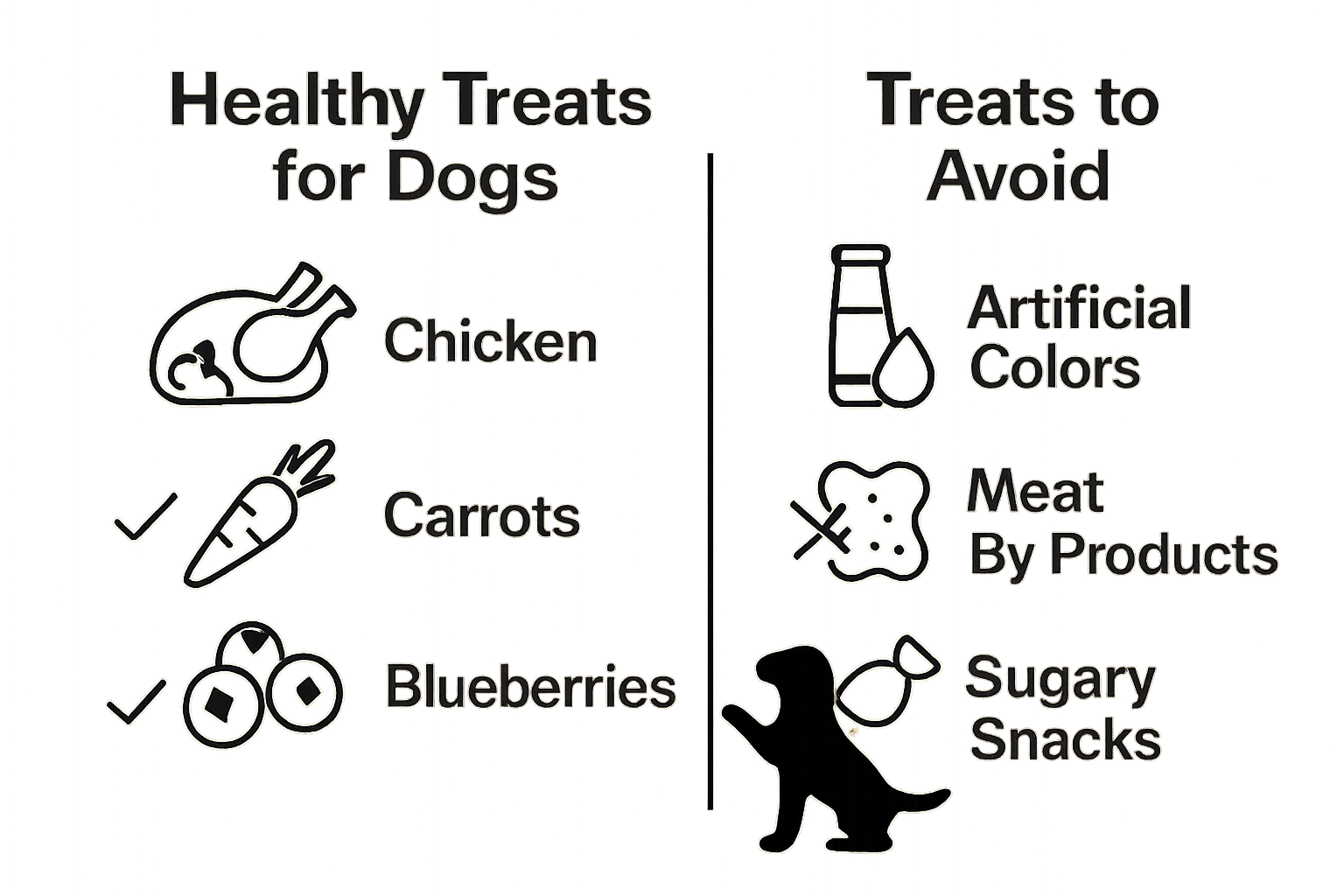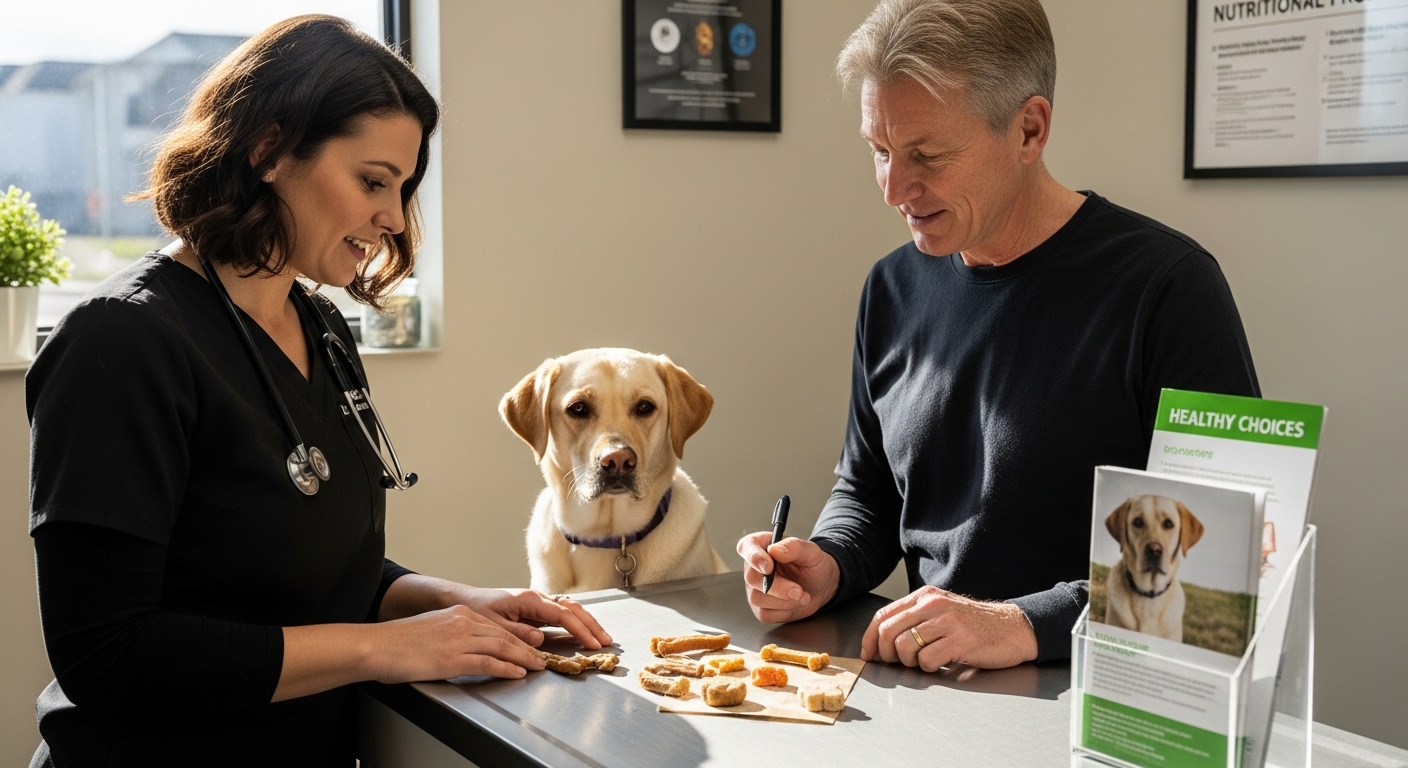
Understanding Healthy Treats for Dogs: Nutrition Insights
Share
Picking out treats for your dog might seem easy, but the real story is in the details. Most people grab the tastiest option without realizing that treats should make up no more than 10 percent of a dog’s total daily calories. Surprise, right? Yet even that tiny portion can make a huge impact on your dog’s health and behavior when you get the ingredients and balance just right.
Table of Contents
- What Are Healthy Treats For Dogs? Key Ingredients And Benefits
- Why Healthy Treats Matter: Impact On Dog Health And Behavior
- The Nutritional Profile Of Healthy Dog Treats: What To Look For
- Real-World Examples: Popular Healthy Treats And Their Benefits
- Breeds And Life Stages: Tailoring Treats For Your Dog’s Needs
Quick Summary
| Takeaway | Explanation |
|---|---|
| Choose quality ingredients for dog treats | Opt for treats with real meat, minimal processing, and no artificial additives to support your dog’s health. |
| Limit treats to 10% of daily calories | Treats should not exceed 10% of your dog’s daily caloric intake to prevent obesity and related health issues. |
| Select treats that promote training and bonding | Use nutritious treats as rewards during training to reinforce good behavior and strengthen the human-dog relationship. |
| Consider breed and age-specific needs | Tailor treat choices based on breed size and life stage to meet your dog’s unique nutritional requirements. |
| Explore functional treats for targeted benefits | Look for treats that offer specific health benefits like joint support or dental health to contribute to overall wellness. |
What Are Healthy Treats for Dogs? Key Ingredients and Benefits
Healthy treats play a crucial role in a dog’s nutrition and overall wellness. More than just rewards, these carefully selected snacks can provide essential nutrients, support training efforts, and contribute to your dog’s health when chosen wisely. Understanding the key ingredients and nutritional benefits helps pet owners make informed decisions about their dog’s diet.
Nutritional Components of Quality Dog Treats
Quality dog treats should offer more than just empty calories. According to research from the Royal Veterinary College, treats must be balanced and contribute positively to a dog’s dietary needs. Key nutritional components include:
- Protein Sources: High-quality animal proteins support muscle development and provide essential amino acids
- Natural Ingredients: Whole food components that offer vitamins and minerals
- Low Calorie Options: Treats that supplement diet without excessive weight gain
The ideal treat should complement a dog’s regular diet, providing supplemental nutrition without disrupting overall dietary balance.
The table below summarizes the essential nutritional components of healthy dog treats and explains their importance for canine well-being.
| Nutritional Component | Description | Key Benefits |
|---|---|---|
| High-Quality Protein | Sourced from real meat or identifiable animal sources | Supports muscle development, energy |
| Healthy Fats | Includes omega-3 and omega-6 fatty acids | Promotes skin and coat health |
| Complex Carbohydrates | Provided through minimally processed whole foods | Offers slow-release energy |
| Natural Ingredients | Utilizes whole foods rich in vitamins and minerals | Enhances immune and metabolic health |
| Low-Calorie Options | Keeps treat calorie content minimal | Helps prevent obesity |
| No Artificial Additives | Free from synthetic preservatives, colors, or flavors | Reduces risk of long-term health issues |
| This means selecting treats with real meat proteins, minimal processing, and no artificial additives. |
Understanding Treat Quantity and Quality
Pet owners must recognize that treats should constitute no more than 10% of a dog’s daily caloric intake. University of Cambridge veterinary research emphasizes the importance of careful treat management to prevent obesity and related health complications. Strategies for responsible treat giving include:
- Measuring treats against the dog’s total daily food allowance
- Selecting nutrient-dense options over empty calorie snacks
- Using treats primarily for training and positive reinforcement
By choosing high-quality, nutritionally balanced treats, pet owners can support their dog’s health while maintaining an enjoyable reward system that strengthens the human-animal bond.
Why Healthy Treats Matter: Impact on Dog Health and Behavior
Treats are more than simple rewards. They serve as powerful tools for communication, training, and supporting a dog’s overall physical and mental well-being. Understanding the deeper implications of treat selection can transform how pet owners approach nutrition and behavior management.
Behavioral and Training Benefits
Healthy treats are essential psychological motivators in dog training and relationship building.
According to research from the American Veterinary Society of Animal Behavior, positive reinforcement using nutritious treats helps establish strong learning pathways and strengthens the human-dog bond. Well-chosen treats can:
- Create positive associations with training activities
- Encourage desired behavioral responses
- Build trust and communication between dogs and owners
Mental stimulation through treat-based training goes beyond simple reward mechanisms. By selecting treats that engage a dog’s senses and provide nutritional value, owners can simultaneously support cognitive development and reinforce good behavior.
Nutritional Impact on Long-Term Health
The nutritional composition of treats directly influences a dog’s physical health trajectory. Research from the UK Veterinary Journal emphasizes that treats are not mere supplementary items but potential contributors to overall metabolic health. Strategic treat selection can address specific health objectives like supporting joint health, improving coat condition, or managing weight.
Key health considerations include choosing treats with:
- Functional ingredients that provide targeted nutritional benefits
- Low glycemic index to prevent blood sugar spikes
- Minimal artificial preservatives that could compromise long-term wellness
By understanding holistic dog nutrition, pet owners can transform treats from simple rewards into powerful tools for preventative health management. The right treats become more than snacks they become integral components of a comprehensive wellness strategy.
The Nutritional Profile of Healthy Dog Treats: What to Look For
Navigating the world of dog treats requires a comprehensive understanding of nutritional profiles and ingredient quality. Not all treats are created equal, and discerning pet owners must look beyond marketing claims to ensure they are providing genuine nutritional value to their canine companions.
Essential Nutritional Components
Healthy dog treats should offer more than empty calories. According to research from the Royal Veterinary College, high-quality treats must provide balanced nutrition that supports overall health. The critical nutritional components include:
- Protein Quality: Animal-based proteins that provide complete amino acid profiles
- Healthy Fats: Omega-3 and omega-6 fatty acids supporting coat and skin health
- Complex Carbohydrates: Slow-release energy sources with minimal processing
Protein source is particularly crucial. Treats containing whole meat proteins from identifiable animal sources provide superior nutritional benefits compared to generic meat by-products.
Identifying Red Flags in Treat Ingredients
Discerning pet owners must develop skills to recognize problematic ingredients.
 Learn how to read dog food ingredients carefully to distinguish between nutritious and potentially harmful components. Warning signs in treat ingredients include:
Learn how to read dog food ingredients carefully to distinguish between nutritious and potentially harmful components. Warning signs in treat ingredients include:
- Artificial preservatives and synthetic colors
- Unnamed meat sources or generic “meat meal”
- High sugar or salt content
- Excessive grain or filler ingredients
The goal is selecting treats that function as miniature nutritional supplements, providing targeted health benefits while remaining delicious for dogs.
 Veterinary nutritionists recommend treats that complement a dog’s primary diet, offering concentrated nutrients without disrupting overall dietary balance.
Veterinary nutritionists recommend treats that complement a dog’s primary diet, offering concentrated nutrients without disrupting overall dietary balance.
Real-World Examples: Popular Healthy Treats and Their Benefits
Selecting the right treats goes beyond simple flavor preferences. Understanding the specific nutritional benefits of different treat options helps pet owners make informed choices that contribute to their dog’s overall health and well-being.
Natural Whole Food Treats
Natural whole food treats offer exceptional nutritional advantages. Understanding raw vs kibble dog food principles similarly apply to treat selection. According to research from the Kennel Club, several whole food options provide targeted health benefits:
- Lean Chicken: High protein content supporting muscle development
- Carrots: Low calorie, rich in beta-carotene for eye health
- Blueberries: Antioxidant powerhouses supporting cellular health
- Pumpkin: Supports digestive function and provides essential fiber
Moderation remains key. These treats should complement, not replace, a balanced dietary regimen. Veterinary nutritionists recommend treats comprise no more than 10% of a dog’s daily caloric intake.
Functional Treats with Specific Health Benefits
Beyond basic nutrition, certain treats offer targeted health support. Functional treats can address specific wellness objectives, transforming snack time into an opportunity for proactive health management. Critical considerations include:
- Joint support treats with glucosamine for mobility
- Dental chews promoting oral hygiene
- Omega-rich treats supporting coat and skin health
- Probiotic treats enhancing digestive wellness
By strategically selecting treats that provide more than simple calories, pet owners can actively contribute to their dog’s long-term health and quality of life. The goal is creating a treat selection that feels like a reward while simultaneously supporting comprehensive canine wellness.
Breeds and Life Stages: Tailoring Treats for Your Dog’s Needs
Dogs are not a monolithic group. Each breed and individual dog requires a nuanced approach to nutrition, with treats playing a critical role in supporting specific health requirements across different life stages. Understanding these unique dietary needs helps pet owners provide targeted nutritional support.
Breed-Specific Nutritional Considerations
Breed size and genetic predispositions dramatically influence treat selection. According to research from the Kennel Club, different breeds have distinct metabolic profiles and nutritional requirements:
- Small Breeds: Higher metabolism, require calorie-dense treats
- Large Breeds: Prone to joint issues, benefit from glucosamine-enriched treats
- Working Breeds: Need high-protein treats supporting muscle maintenance
- Brachycephalic Breeds: May require softer treats accommodating dental structures
Genetic factors significantly impact treat selection. Some breeds have higher risks of specific health conditions, making targeted nutritional support crucial.
Life Stage Nutritional Progression
Nutritional needs evolve dramatically from puppyhood through senior years. Expert tips for transitioning dog foods apply similarly to treat selection. Nutritional requirements transform across life stages:
This comparison table outlines how treat needs and recommendations change across different dog life stages, helping pet owners select the most appropriate option for their companions.
| Life Stage | Treat Characteristics | Key Nutritional Focus |
|---|---|---|
| Puppy | High-protein, calorie-dense, soft | Growth support, energy, gentle digestion |
| Adult Dog | Balanced, moderate calories | Weight maintenance, overall wellness |
| Senior Dog | Lower-calorie, joint/cognitive support | Mobility, cognitive health, easy to chew |
| Pregnant/Nursing Dog | Nutrient-dense, high protein/fat | Increased energy, nutrient support |
- Puppies: High-calorie, protein-rich treats supporting growth
- Adult Dogs: Balanced treats maintaining optimal weight
- Senior Dogs: Lower-calorie treats with joint and cognitive support
- Pregnant/Nursing Dogs: Nutrient-dense treats supporting additional metabolic demands
By recognizing these nuanced nutritional needs, pet owners can transform treats from simple rewards into strategic health interventions. The goal is creating a personalized treat approach that supports each dog’s unique physiological journey.
Make Treat Time Truly Healthy for Your Dog
Are you searching for dog treats that offer genuine nutritional value instead of empty calories? If you are concerned about artificial additives, ingredient quality, or the negative health effects of poor treat choices, you are not alone. Many dog owners want to support their pet’s long-term well-being through treats that complement balanced diets and target important needs like digestion, skin health, and energy levels. The article explained how choosing real, functional treats can have a lasting impact on your dog’s happiness, behavior, and health. You deserve peace of mind each time you reward your companion.

Explore our expertly-curated range of healthy dog treats and functional foods for every breed and life stage. From puppy formulas with optimized nutrition to senior blends focused on gentle digestion, Ultimate Pet Foods gives you the science-backed support your dog truly deserves. Visit https://ultimatepetfoods.co.uk right now to discover better choices for your best friend. Give treats that go beyond taste and make a real difference today.
Frequently Asked Questions
What are the key nutritional components of healthy dog treats?
Healthy dog treats should include high-quality protein sources, natural ingredients, and low-calorie options to support a balanced diet and overall canine health.
How can I determine the right quantity of treats for my dog?
Treats should make up no more than 10% of your dog’s daily caloric intake. Measuring treats against their total daily food allowance helps in managing their diet effectively.
What should I look for in the ingredients of dog treats?
Focus on treats with whole meat proteins, minimal processing, no artificial additives, and avoid those with excessive sugar, salt, or unnamed meat sources.
Are there specific treats for different dog breeds or life stages?
Yes, different breeds and life stages have unique nutritional needs. For instance, small breeds may require calorie-dense treats, while senior dogs benefit from lower-calorie options with joint support.
